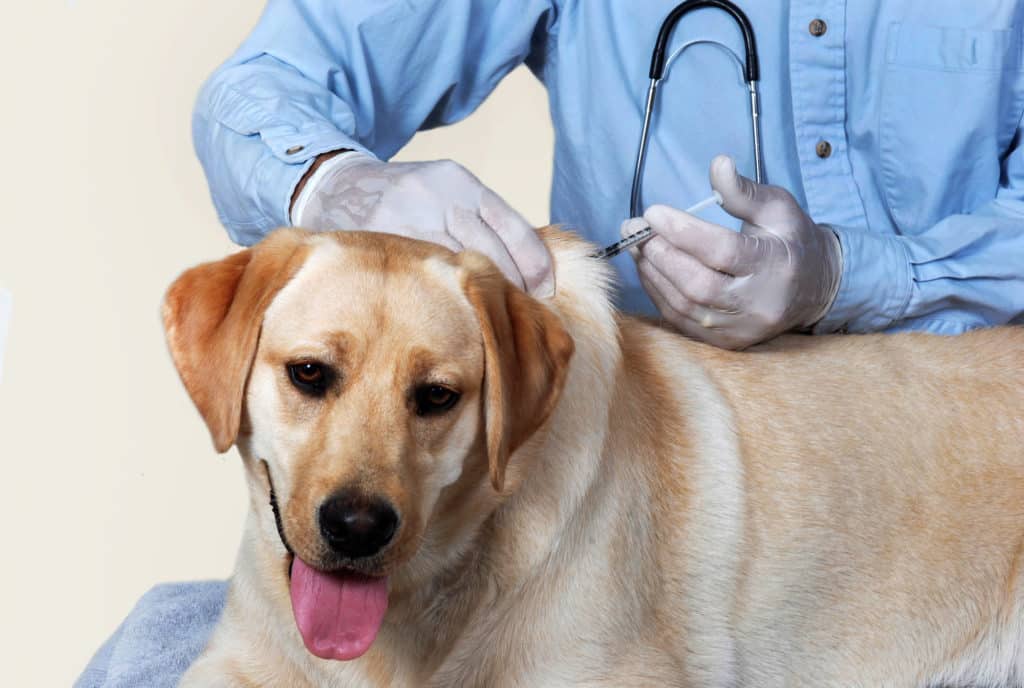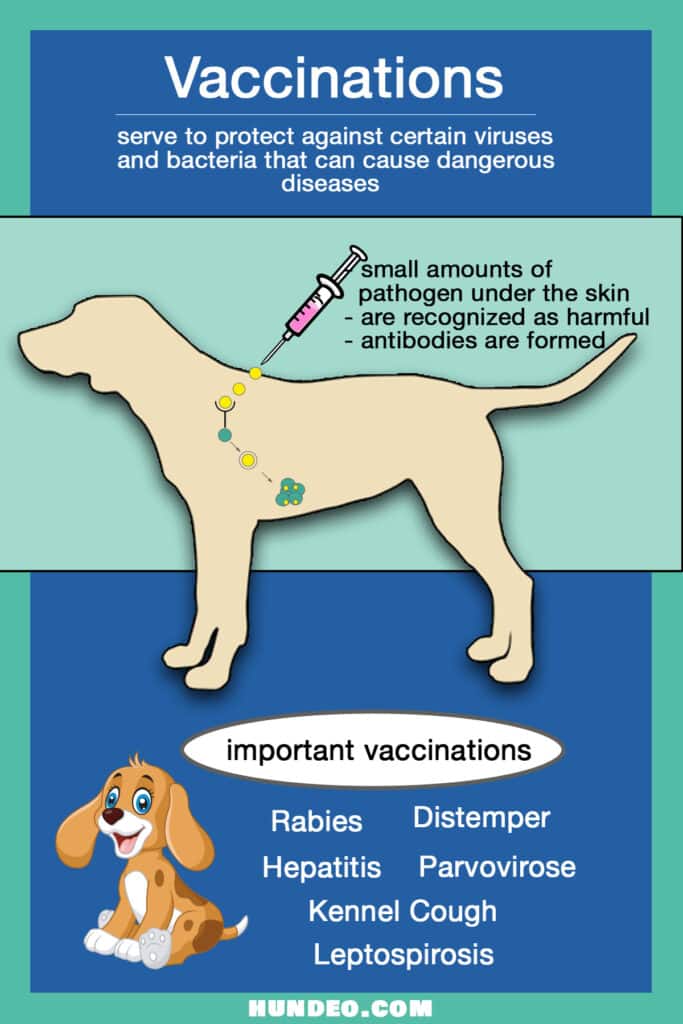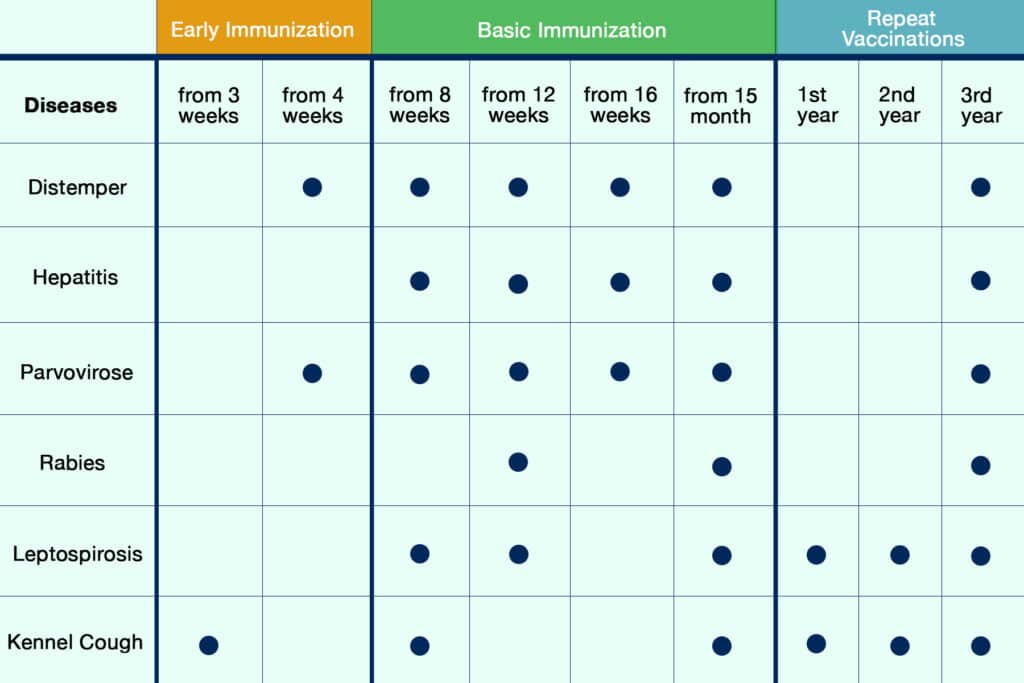The 7 most important vaccinations for your dog
- Veterinarian Mag.med.vet. Emin Jasarevic
- Updated: 2023-08-31
You want to learn more about vaccinations for dogs? Then you are right here. We'll show you the 3 types of vaccines and which 7 are really important. Also, for this article we have chosen Advice from veterinarian Mag.med.vet. Emin Jasarevic obtained. Note: This article is written for the german country.

There are 3 types of vaccines: Live vaccines, inactivated vaccines and combination vaccines.
How vaccinations work
Vaccinations are used to protect against certain viruses and bacteria that can cause dangerous diseases. The principle of immunization in dogs is the same as in us humans.
Small amounts of pathogens or parts of pathogens are injected into the muscles, mucous membranes or under the skin so that the body builds up defenses.
Only a few weeks after birth, puppies are passively immune through the mother. This means that they cannot get certain diseases, because they have absorbed the mother's antibodies partly through the mother's milk and partly already in the womb. After a few weeks, however, this protection wears off.
Active immunity through vaccinations
Normally, natural immunization occurs as pathogens are fought by the body. When antigens, i.e. bacteria, viruses or other foreign bodies, enter the body, they are recognized by the immune system as harmful. Special antibodies are then formed that attack these antigens and render them harmless.
If the same pathogens enter the organism again later, the probability of a new infection is significantly lower. This is because the antibodies remain in the blood for a long time and can fight the antigens immediately.
Vaccinations work on the same principle. That is why they are also called artificial immunizations.
Injections are used to introduce attenuated, live or, in most cases, dead bacteria or viruses into the body. The immune system then produces antibodies to fight the pests.
The small amount of pathogens is rendered harmless by the immune system. At the same time, no infection can occur because the pathogens are already killed in most vaccinations. However, antibodies that have been created remain for a long time and prevent a later illness.
Most vaccinations must be repeated several times at intervals of a few weeks. This allows the maximum number of defenses to be formed by the body and your furry friend is then completely immune for a certain time.
After a few years, the vaccinations must be refreshed. This is because the antibodies are broken down again by the body over time. However, if a small amount of the pathogens is introduced into the body after one or more years, immunity can return to a high level.
The risks
Of course, vaccinations always carry a little risk. Finally, bacteria or viruses are injected into the body. In rare cases, inflammation or allergies can then occur.
If your protégé is already sick or weakened before the vaccination, the small dose of pathogens may be enough to trigger an infection.
However, these disadvantages are rather exceptions.
Keep in mind that vaccinations have a much greater benefit than they can do harm.
Through them you protect not only your hairy companion from diseases, but also his entire environment. Now he can not transmit dangerous diseases to conspecifics.
What else you should know about vaccinations

Too many vaccinations do not benefit the dog, on the contrary, it can unnecessarily stress the body.
Therefore, only the really important vaccinations should be carried out. For all others, it must be weighed whether they are useful for the respective coat carrier with the corresponding conditions.
In addition to this, there is also a wide range of Elective Vaccinations. They protect against diseases that occur rarely or do not have such serious consequences for the animal. They are recommended when your pet is particularly at risk for a disease for certain reasons.
For example, do you live in an area where there are many ticks? Does your dog often run through meadows and forests? Then vaccinations against diseases transmitted by ticks are useful. These are babesiosis or borreliosis.
Whether you should carry out certain vaccinations, you can discuss individually with your veterinarian.
3 types of vaccines
Depending on the disease they protect against, there are also different types of vaccines. Here you will find a summary of the three most important ones, as well as their advantages and disadvantages.
1. live vaccines
The pathogens that are brought into the body have not yet been killed.
This means that they can theoretically multiply and cause infection. However, they are attenuated and are used in such a low dose injected, that the immune system of your protégé can fight it without problems. So the disease does not break out in the normal case.
In this way, the worst-case scenario is rehearsed, so to speak, and the body's defenses can already prepare to fight an impending infection.
In weakened or sick dogs, the immune system is no longer as strong. It could be that the immune system cannot completely fight the pathogens after a vaccination with live vaccines.
| Advantages & Benefits | Disadvantages |
|---|---|
|
|
|
2. inactivated vaccines
The bacteria and viruses that are in the syringe have already been killed beforehand. They can no longer multiply or cause an infection. Sometimes only parts of the pathogens, the antigens, are injected.
However, not as many antibodies are formed for the killed pathogens as against live ones. The immunization is therefore not quite as strong as with live vaccines.
| Advantages & Benefits | Disadvantages |
|---|---|
|
|
|
3. combination vaccines
Often the veterinarian offers vaccinations that protect against several diseases at once.
The syringes contain antigens from several different pathogens.
However, the body must thereby Combat multiple pathogens at the same time and does not focus on one. That is why the protection is mostly not quite as strong as for individual vaccinations.
In addition, the Make booster vaccinations more difficult. Some vaccines last longer than others and vaccinations may need to be boostered at different times.
So check with your veterinarian beforehand to see if this will cause any problems. can come.
| Advantages & Benefits | Disadvantages |
|---|---|
|
|
|
Increased vaccination protection through basic immunization
Most vaccinations must be given several times at intervals of about four weeks. Thus, the highest possible protection is created. This will also Basic immunization called.
This procedure begins with puppies for the most part already after the 8th week of life. This means they are well protected from the start.
Booster vaccinations then continue to extend protection. Depending on the disease, the vaccination must be given again either after one or after three years.
The cost of basic immunization are high at first due to the multiple vaccinations. But if your pet is protected against the most important diseases, it is worth it.
Vaccinations for puppies
In the first weeks of life, our four-legged friends are still immune to many diseases without vaccinations. Through the mother's milk, the mother gives her puppies some important antibodies that protect them from diseases.
It is advisable to have the bitch vaccinated again before she becomes pregnant. The more antibodies it forms beforehand, the more it can pass on to its offspring.
Sometimes a puppy gets less mother's milk than his siblings. Because he is weaker, he may then be displaced by the other young dogs. Accordingly, the protection against diseases is also lower and does not last quite as long.
Over time, the maternal antibodies are broken down again. If immunity then wanes, but there are still enough defenses to block a vaccination, this is called the immunological gap.
Only a few vaccines have been developed so that they can be administered as early as the 4th week of life. So right in that gap. Most vaccines are given from the 8th week of life.
Vaccination schedule
In the left column you will find the most important vaccinations for your pelt nose. Normally, the first injection for the basic immunization is given in the 8th week of life of the puppy. The vaccinations for distemper, parvovirosis and kennel cough can also be given earlier. This is then called early immunization.
The dots show you when to do the vaccinations. For example, the basic immunization for rabies takes place in the 12th week and is repeated when your dog is 15 months old. Every 3 years the protection must be refreshed.
If you have any other questions about the vaccination schedule, you can ask your veterinarian for advice.

The 7 most important vaccinations
Of the many vaccinations that are offered, not all are important for your pet. But which ones you have to do urgently and which ones you should consider, you can find here.
1. rabies
This viral infection is transmitted via saliva, for example through a bite from an infected animal. The first symptoms are behavioral changes and many neurological symptoms.
This vaccination is an important protection for your dog and the dog owner, because rabies is a zoonosis, i.e. is transmissible from animal to human and vice versa. This disease is fatal for humans and animals.
The vaccination is given at the earliest in the 12th week of life. Every 3 years the protection should be refreshed.
2. distemper
It is highly contagious. The disease is transmitted via droplet infection, i.e. by direct contact.
Canine distemper causes inflammation in the lungs, intestines and brain. In many cases it is fatal.
The basic immunization can be performed as early as the 4th week, but should be performed no later than the 8th week. In the 12th, 16th week of life and 15th month of life the vaccination should be repeated. This would complete the basic immunization. With certain vaccines, it is sufficient if the booster is given every 3 years.
Vaccination against distemper is often combined as a 6-vaccination against distemper, parvovirosis, HCC, rabies, leptospirosis and kennel cough.
3. parvovirosis
There is a high risk of infection with this viral infection. It is transmitted via excrement. Your pet could become infected by drinking water from a lake.
Symptoms include severe vomiting, watery and bloody diarrhea, and fever. If blood poisoning occurs, the disease can be fatal.
The vaccine can be given as early as the 4th week of life, but should be given no later than the 8th week. In the 12th, 16th week of life and in the 15th month of life the vaccination should be repeated. This would complete the basic immunization. The booster vaccination then takes place every 3 years.
4. leptospirosis
This disease is caused by bacteria. It can be transmitted through urine. It causes many organ damage such as kidney damage, jaundice and bleeding in the lungs. If vital organs are affected, the disease can be fatal.
It is performed from the 8th week of life, is repeated after 4 weeks and then must be refreshed annually.
5. hepatitis
Vomiting, nausea and jaundice are caused by this viral infection. It is often fatal.
The vaccination is given from the 8th week. In the 12th, 16th week of life and in the 15th month of life the vaccination should be repeated. This would complete the basic immunization. Subsequently, every 3 years is refreshed.
6. canine infectious tracheobronchitis
The so-called kennel cough is one of the mixed infections, since several pathogens are involved in the disease. Typical for this disease is a strong, barking cough. It is highly contagious.
7. borreliosis
This bacterial disease is also transmitted by ticks. The symptoms are manifold. For example, joint inflammation and organ damage can occur.
Unfortunately, the vaccine is not effective against all species of Borrelia, which is why protection against ticks is usually more effective. That is why the vaccination against Lyme disease belongs to the Elective Vaccinations.
The first vaccination is possible from the age of 12 weeks. A revaccination takes place after three to five weeks. The repeat vaccinations are to be carried out at annual intervals.
Frequently Asked Questions
Vaccination refers to the process of administering a vaccine to a living being. The goal is to make the patient immune to a pathogen. Vaccination in humans differs little from that of a dog.
Vaccination involves administering very small amounts of an attenuated or dead pathogen to the patient. As a result, the immune system forms antibodies against this pathogen without an outbreak of disease. These antibodies make the patient immune to the pathogen.
In rare cases, allergic reactions or the outbreak of a disease may occur. However, the risk of dying from a disease without vaccination is much greater. Therefore, the benefits of vaccination easily outweigh the risks.
No vaccination is mandatory, but some vaccinations are highly recommended. Without them, your dog is not sufficiently protected and can easily succumb to deadly diseases like rabies. In our article you will find the most important vaccinations.
The duration of effect of vaccinations depends on the respective active ingredient. Your veterinarian can tell you when you need to refresh the vaccinations with the help of your dog's vaccination certificate.
Veterinarian’s Recommendation
Vaccinations are an important protection for our dogs. They save them from many serious diseases and therefore much suffering. That is why every dog owner should be informed about the most important vaccinations and have them performed regularly by the veterinarian.
Even if your protégé does not like to get a shot: Afterwards, you can take him for a walk and romp around with a clear conscience. You no longer have to worry that dangers in the form of bacteria or viruses could be lurking everywhere.

I am a veterinarian and writer on animal health topics. Animals are my passion, and it is my personal goal to create medically accurate articles and videos to educate pet owners as much as possible.
Share Now:

